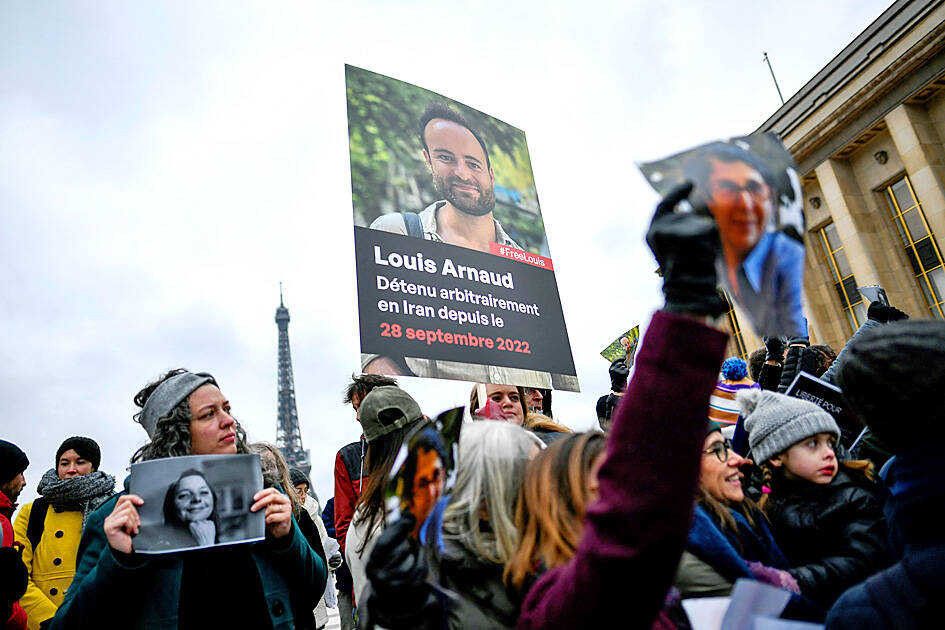Sylvie Arnaud’s first feeling when she learned her son, Louis Arnaud, had been detained in Iran in September last year was sheer incredulity, followed by a raging sense of injustice and impotence.
“We don’t know how long this will last. We don’t know what the Iranians are waiting for and we will probably never know,” she said.
Louis Arnaud, described by his family as a passionate traveler who simply wanted to see the world, is one of four French nationals held in prison in Iran.

Photo: AFP
He is also among at least a dozen Western nationals jailed in what campaigners and some governments describe as a deliberate strategy of hostage-taking by the Islamic republic to extract concessions.
Yet Iran is far from the only country accused of pursuing such a strategy, with the likes of China, Russia and Venezuela seen as holding innocent foreigners on trumped-up charges of espionage or other security-related allegations — people who simply had the misfortune to be in the wrong place at the wrong time.
Precedents have shown the prisoners are generally only released in exchange for something — either for other detainees or assets — forcing Western governments into the uncomfortable position of knowingly negotiating over hostage-takings.
Such negotiations are hugely time-consuming, painstaking, often conducted through intermediaries and, even if a deal is reached, can collapse at the last minute.
“At the beginning, I didn’t want to think that it was political, and time has now passed ... without anything happening,” Sylvie Arnaud said.
Western governments have often made major concessions to secure the release of their nationals held abroad.
The US authorized the transfer of US$6 billion in Iranian funds frozen in South Korea and the release of five Iranians to facilitate the release of five Americans jailed by Iran. After being released from prison, the Americans are now held under house arrest and should go home when the transaction is completed.
This exchange has already been criticized for not including two US residents: German national Jamshid Sharmahd who is facing the death penalty and Virginia-based Iranian Shahab Dalili, who was arrested in 2016 while visiting Tehran.
At the end of May, Belgian humanitarian Olivier Vandecasteele was released after 15 months of detention in Iran, in exchange for Iranian diplomat Assadollah Assadi, who had been sentenced in Belgium in 2021 to 20 years in prison on terror charges for seeking to bomb an opposition rally outside Paris.
In October last year, seven US prisoners held in Venezuela were released in exchange for two individuals close to Venezuelan President Nicolas Maduro.
Russia in December last year released Women’s National Basketball Association star Brittney Griner, who had been held since February last year on charges of possessing vape cartridges with a small quantity of cannabis oil.
However, she was only freed in exchange for notorious Russian arms dealer Viktor Bout — known as the “Merchant of Death” — who had been jailed in the US.
Former US marine Paul Whelan, imprisoned in Russia for over four years, remains in a penal colony while Russia in March arrested another US citizen, Wall Street Journal reporter Evan Gershkovich.
Etienne Dignat, a political scientist at Sciences Po university in Paris, said governments face a “dilemma.”
“By unfreezing assets and exchanging prisoners, they are in a certain way rewarding a crime and encouraging states to continue their hostage diplomacy,” said Dignat, the author of a book on hostage-taking.
Daren Nair, a security consultant and campaigner who runs a podcast on hostage diplomacy, said the number of victims had risen in the past few years.
“The majority of Americans held captive abroad 10 years ago were held by non-state actors in countries like Syria, Yemen and Somalia... Today, the majority of Americans held captive abroad are being held by state actors like Iran, Venezuela, Russia and China,” Nair said.
Once nationals are taken, governments have no choice but to negotiate with their captors, he said.
More should be done to thwart the strategy in the first place, he said.
Nair said the two ways to stop hostage diplomacy are to “punish the individuals responsible within these hostage-taking states and continuously raise awareness so your citizens stop traveling to these countries.”
“In general the only way to get a hostage home is to negotiate,” Journalism Protection Initiative founding director Joel Simon said. “Other strategies — such as rescues — are rarely successful.”
“Unless we engage with hostage takers — whether they be states or non-state actors — the hostage will probably be killed or will languish in detention or prison for an extended period,” Simon said.
Blandine Briere never doubted the innocence of her brother Benjamin Briere who was finally freed in May after being held for three years in Iran on charges of espionage.
She recalled how the family felt plunged into an “impasse.”
“We discovered a world that was unknown in normal life,” Blandine Briere said, recalling how the family offered support, but was “constantly walking on eggshells because we did not know if it can have a positive or negative impact.”

When Shanghai-based designer Guo Qingshan posted a vacation photo on Valentine’s Day and captioned it “Puppy Mountain,” it became a sensation in China and even created a tourist destination. Guo had gone on a hike while visiting his hometown of Yichang in central China’s Hubei Province late last month. When reviewing the photographs, he saw something he had not noticed before: A mountain shaped like a dog’s head rested on the ground next to the Yangtze River, its snout perched at the water’s edge. “It was so magical and cute. I was so excited and happy when I discovered it,” Guo said.

TURNAROUND: The Liberal Party had trailed the Conservatives by a wide margin, but that was before Trump threatened to make Canada the US’ 51st state Canada’s ruling Liberals, who a few weeks ago looked certain to lose an election this year, are mounting a major comeback amid the threat of US tariffs and are tied with their rival Conservatives, according to three new polls. An Ipsos survey released late on Tuesday showed that the left-leaning Liberals have 38 percent public support and the official opposition center-right Conservatives have 36 percent. The Liberals have overturned a 26-point deficit in six weeks, and run advertisements comparing the Conservative leader to Trump. The Conservative strategy had long been to attack unpopular Canadian Prime Minister Justin Trudeau, but last month he

Chinese authorities said they began live-fire exercises in the Gulf of Tonkin on Monday, only days after Vietnam announced a new line marking what it considers its territory in the body of water between the nations. The Chinese Maritime Safety Administration said the exercises would be focused on the Beibu Gulf area, closer to the Chinese side of the Gulf of Tonkin, and would run until tomorrow evening. It gave no further details, but the drills follow an announcement last week by Vietnam establishing a baseline used to calculate the width of its territorial waters in the Gulf of Tonkin. State-run Vietnam News

PROBE: Last week, Romanian prosecutors launched a criminal investigation against presidential candidate Calin Georgescu accusing him of supporting fascist groups Tens of thousands of protesters gathered in Romania’s capital on Saturday in the latest anti-government demonstration by far-right groups after a top court canceled a presidential election in the EU country last year. Protesters converged in front of the government building in Bucharest, waving Romania’s tricolor flags and chanting slogans such as “down with the government” and “thieves.” Many expressed support for Calin Georgescu, who emerged as the frontrunner in December’s canceled election, and demanded they be resumed from the second round. George Simion, the leader of the far-right Alliance for the Unity of Romanians (AUR), which organized the protest,